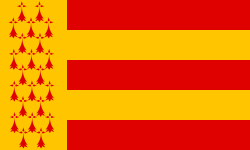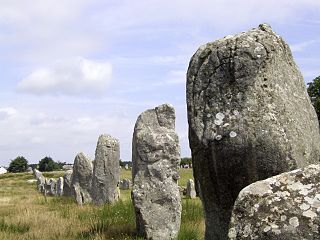 W
WBigouden, historically known as Cap Caval, is, along the Bay of Audierne, the most south-western area of Bro Kernev in Brittany, south-west of Quimper, defined since 1790 in the French department of Finistère. The designation was an informal label taken from the name of the distinctive headdress traditionally worn by the local women. By the end of the 19th century, the name then slipped to designate the women of the area, then to describe all its inhabitants. It has since been formalised within the administration and promotion of the region.
 W
WGwened, Bro-Gwened or Vannetais is a historic realm and county of Brittany in France. It is considered part of Lower Brittany.
 W
WThe Carnac stones are an exceptionally dense collection of megalithic sites near the south coast of Brittany in northwestern France, consisting of stone alignments (rows), dolmens, tumuli and single menhirs. More than 3,000 prehistoric standing stones were hewn from local granite and erected by the pre-Celtic people of Brittany and form the largest such collection in the world. Most of the stones are within the Breton village of Carnac, but some to the east are within La Trinité-sur-Mer. The stones were erected at some stage during the Neolithic period, probably around 3300 BCE, but some may date to as early as 4500 BCE.
 W
WCornouaille is a historical region on the west coast of Brittany in West France. The name is cognate with Cornwall in neighbouring Great Britain. This can be explained by the settlement of Cornouaille by migrant princes from Cornwall who created an independent principality founded by Rivelen Mor Marthou, and the founding of the Bishopric of Cornouaille by ancient saints from Cornwall. Celtic Britons and the settlers in Brittany spoke a common language, this language would evolve into Breton, Welsh and Cornish.
 W
WThe Tufs et calcaires de Rosan is a geologic formation in France. It preserves fossils dating back to the Katian to Hirnantian stages of the Late Ordovician period.
 W
WLower Brittany denotes the parts of Brittany west of Ploërmel, where the Breton language has been traditionally spoken, and where the culture associated with this language is most prolific. The name is in distinction to Upper Brittany, the eastern part of Brittany, which is of a predominantly Romance culture.
 W
WPaimpont Forest also known as Brocéliande Forest is a temperate forest located around the village of Paimpont in the department of Ille-et-Vilaine in Brittany, France. Covering an area of 9,000 hectares, it includes the castles Château de Comper and Château de Trécesson as well as the national historical site the Forges of Paimpont, and is part of a larger forest area that covers the neighboring departments of Morbihan and Côtes-d'Armor. It has been associated with the forest of Brocéliande and many locations from the Arthurian legend, including Val sans retour, the tomb of Merlin, and the fountain of Barenton.
 W
WThe Pays de la Mée is a historical region of Brittany, nowadays in France which was part of the Duchy of Brittany before the French Revolution. It was then split between Loire-Atlantique and Ille-et-Vilaine department. Its capital is Châteaubriant, and the dialect traditionally spoken there is the Gallo language, which is a Romance language compared to the Breton language which is a Celtic language.
 W
WThe Pays de Retz is a historical subregion of France that currently forms part of the Loire-Atlantique department, but which previously formed part of the Duchy of Brittany.
 W
WThe Tumulus of St. Michel is a megalithic grave mound, located east of Carnac in Brittany, France. It is the largest grave mound in continental Europe.
 W
WTrégor, officially the Land of Trégor is one of the nine traditional provinces of Brittany, in its northwestern area. It comprises the western part of the Côtes-d'Armor and a small part of the northeast of Finistère, as far as the river Morlaix. Its capital is Tréguier, the French translation of the Breton word Landreger.
 W
WUpper Brittany is the eastern part of Brittany, France, which is predominantly of a Romance culture and is associated with the Gallo language. The name is in counterpoint to Lower Brittany, the western part of the ancient province and present-day region, where the Breton language has traditionally been spoken. However, there is no certainty as to exactly where the line between 'Upper' and 'Lower' Brittany falls.